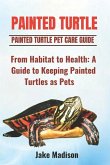The yellow-bellied slider (Trachemys scripta scripta) is a semi-aquatic freshwater turtle native to the southeastern United States. It is a subspecies of the pond slider and is recognized for the distinctive yellow markings on its head, legs, and plastron (underside of the shell). These turtles are highly adaptable, thriving in a variety of water environments, including lakes, ponds, marshes, and slow-moving rivers. One of the most distinctive features of the yellow-bellied slider is its ability to bask for extended periods. These turtles are often seen perched on rocks or logs, absorbing sunlight to regulate their body temperature. Their omnivorous diet includes aquatic plants, algae, insects, small fish, and crustaceans, allowing them to adapt to diverse ecosystems. In terms of size, males typically reach 5-9 inches in length, while females grow larger, averaging between 8-13 inches. Their shells are oval-shaped and slightly domed, providing protection from predators while allowing them to move efficiently in the water. Their webbed feet aid in swimming, making them one of the most agile aquatic turtles. Yellow-bellied sliders are known for their intelligence and strong problem-solving abilities. They quickly learn to recognize their owners, associate them with food, and exhibit behaviors that demonstrate curiosity and awareness of their surroundings. Lifespan and Growth Stages A well-cared-for yellow-bellied slider can live anywhere between 20 to 40 years in captivity, with some even reaching 50 years under optimal conditions. Their growth rate and overall health are significantly influenced by their diet, habitat quality, and medical care. The life stages of a yellow-bellied slider include: 1. Hatchling Stage (0-1 year) o Newly hatched turtles are about 1-1.5 inches in size. o They have a soft shell that hardens with age. o Diet consists mainly of protein-based foods such as small insects, larvae, and aquatic invertebrates. 2. Juvenile Stage (1-4 years) o Rapid growth occurs, with significant development in shell structure. o Turtles start incorporating more plant matter into their diet. o Increased activity and stronger territorial instincts develop. 3. Adult Stage (5+ years) o Shell reaches full size and hardens completely. o Omnivorous diet continues, but adults consume more plant-based foods. o Breeding behavior may emerge, particularly in females looking to nest. Proper care during each stage ensures a strong immune system, healthy bone development, and long-term vitality.
Hinweis: Dieser Artikel kann nur an eine deutsche Lieferadresse ausgeliefert werden.
Hinweis: Dieser Artikel kann nur an eine deutsche Lieferadresse ausgeliefert werden.








